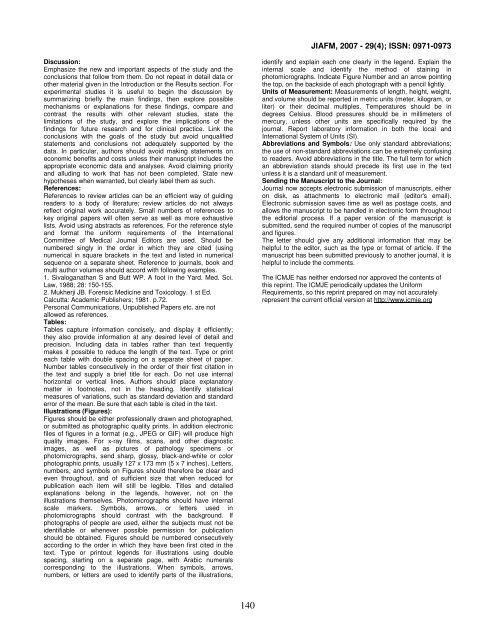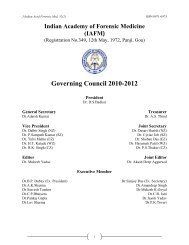Download - forensic medicine
Download - forensic medicine
Download - forensic medicine
You also want an ePaper? Increase the reach of your titles
YUMPU automatically turns print PDFs into web optimized ePapers that Google loves.
JIAFM, 2007 - 29(4); ISSN: 0971-0973<br />
Discussion:<br />
Emphasize the new and important aspects of the study and the<br />
conclusions that follow from them. Do not repeat in detail data or<br />
other material given in the Introduction or the Results section. For<br />
experimental studies it is useful to begin the discussion by<br />
summarizing briefly the main findings, then explore possible<br />
mechanisms or explanations for these findings, compare and<br />
contrast the results with other relevant studies, state the<br />
limitations of the study, and explore the implications of the<br />
findings for future research and for clinical practice. Link the<br />
conclusions with the goals of the study but avoid unqualified<br />
statements and conclusions not adequately supported by the<br />
data. In particular, authors should avoid making statements on<br />
economic benefits and costs unless their manuscript includes the<br />
appropriate economic data and analyses. Avoid claiming priority<br />
and alluding to work that has not been completed. State new<br />
hypotheses when warranted, but clearly label them as such.<br />
References:<br />
References to review articles can be an efficient way of guiding<br />
readers to a body of literature; review articles do not always<br />
reflect original work accurately. Small numbers of references to<br />
key original papers will often serve as well as more exhaustive<br />
lists. Avoid using abstracts as references. For the reference style<br />
and format the uniform requirements of the International<br />
Committee of Medical Joumal Editors are used. Should be<br />
numbered singly in the order in which they are cited (using<br />
numerical in square brackets in the text and listed in numerical<br />
sequence on a separate sheet. Reference to journals, book and<br />
multi author volumes should accord with following examples.<br />
1. Sivaloganathan S and Butt WP. A foot in the Yard. Med. Sci.<br />
Law, 1988; 28: 150-155.<br />
2. Mukherji JB. Forensic Medicine and Toxicology. 1 st Ed.<br />
Calcutta: Academic Publishers; 1981. p.72.<br />
Personal Communications, Unpublished Papers etc. are not<br />
allowed as references.<br />
Tables:<br />
Tables capture information concisely, and display it efficiently;<br />
they also provide information at any desired level of detail and<br />
precision. Including data in tables rather than text frequently<br />
makes it possible to reduce the length of the text. Type or print<br />
each table with double spacing on a separate sheet of paper.<br />
Number tables consecutively in the order of their first citation in<br />
the text and supply a brief title for each. Do not use internal<br />
horizontal or vertical lines. Authors should place explanatory<br />
matter in footnotes, not in the heading. Identify statistical<br />
measures of variations, such as standard deviation and standard<br />
error of the mean. Be sure that each table is cited in the text.<br />
Illustrations (Figures):<br />
Figures should be either professionally drawn and photographed,<br />
or submitted as photographic quality prints. In addition electronic<br />
files of figures in a format (e.g., JPEG or GIF) will produce high<br />
quality images. For x-ray films, scans, and other diagnostic<br />
images, as well as pictures of pathology specimens or<br />
photomicrographs, send sharp, glossy, black-and-white or color<br />
photographic prints, usually 127 x 173 mm (5 x 7 inches). Letters,<br />
numbers, and symbols on Figures should therefore be clear and<br />
even throughout, and of sufficient size that when reduced for<br />
publication each item will still be legible. Titles and detailed<br />
explanations belong in the legends, however, not on the<br />
illustrations themselves. Photomicrographs should have internal<br />
scale markers. Symbols, arrows, or letters used in<br />
photomicrographs should contrast with the background. If<br />
photographs of people are used, either the subjects must not be<br />
identifiable or whenever possible permission for publication<br />
should be obtained. Figures should be numbered consecutively<br />
according to the order in which they have been first cited in the<br />
text. Type or printout legends for illustrations using double<br />
spacing, starting on a separate page, with Arabic numerals<br />
corresponding to the illustrations. When symbols, arrows,<br />
numbers, or letters are used to identify parts of the illustrations,<br />
identify and explain each one clearly in the legend. Explain the<br />
internal scale and identify the method of staining in<br />
photomicrographs. Indicate Figure Number and an arrow pointing<br />
the top, on the backside of each photograph with a pencil lightly.<br />
Units of Measurement: Measurements of length, height, weight,<br />
and volume should be reported in metric units (meter, kilogram, or<br />
liter) or their decimal multiples. Temperatures should be in<br />
degrees Celsius. Blood pressures should be in millimeters of<br />
mercury, unless other units are specifically required by the<br />
journal. Report laboratory information in both the local and<br />
International System of Units (SI).<br />
Abbreviations and Symbols: Use only standard abbreviations;<br />
the use of non-standard abbreviations can be extremely confusing<br />
to readers. Avoid abbreviations in the title. The full term for which<br />
an abbreviation stands should precede its first use in the text<br />
unless it is a standard unit of measurement.<br />
Sending the Manuscript to the Journal:<br />
Journal now accepts electronic submission of manuscripts, either<br />
on disk, as attachments to electronic mail (editor's email).<br />
Electronic submission saves time as well as postage costs, and<br />
allows the manuscript to be handled in electronic form throughout<br />
the editorial process. If a paper version of the manuscript is<br />
submitted, send the required number of copies of the manuscript<br />
and figures.<br />
The letter should give any additional information that may be<br />
helpful to the editor, such as the type or format of article. If the<br />
manuscript has been submitted previously to another journal, it is<br />
helpful to include the comments.<br />
The ICMJE has neither endorsed nor approved the contents of<br />
this reprint. The ICMJE periodically updates the Uniform<br />
Requirements, so this reprint prepared on may not accurately<br />
represent the current official version at http://www.icmie.org<br />
140




![syllabus in forensic medicine for m.b.b.s. students in india [pdf]](https://img.yumpu.com/48405011/1/190x245/syllabus-in-forensic-medicine-for-mbbs-students-in-india-pdf.jpg?quality=85)



![SPOTTING IN FORENSIC MEDICINE [pdf]](https://img.yumpu.com/45856557/1/190x245/spotting-in-forensic-medicine-pdf.jpg?quality=85)

![JAFM-33-2, April-June, 2011 [PDF] - forensic medicine](https://img.yumpu.com/43461356/1/190x245/jafm-33-2-april-june-2011-pdf-forensic-medicine.jpg?quality=85)



![JIAFM-33-4, October-December, 2011 [PDF] - forensic medicine](https://img.yumpu.com/31013278/1/190x245/jiafm-33-4-october-december-2011-pdf-forensic-medicine.jpg?quality=85)

